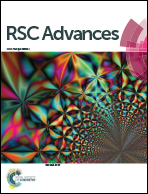An aggregation-induced emission-based fluorescence turn-on probe for Hg2+ and its application to detect Hg2+ in food samples†
Abstract
In this work, we presented a new tetraphenylethene-derived fluorescent probe TPE-M for Hg2+ detection in an aqueous solution. Probe TPE-M is molecularly dissolved in CH3OH/PBS (20 mM, pH = 7.4) (3 : 7, v/v) mixed solution and is almost non-emissive. Reaction of TPE-M with Hg2+ leads to release of an AIE-active precursor 4, and results in a significant fluorescence enhancement. The Hg2+ recognition process has some distinct advantages including rapid response, high selectivity and sensitivity, strong anti-interference ability, and a low detection limit (4.16 × 10−6 M). Moreover, the probe is applicable to detect Hg2+ in real food samples such as shrimp, crab and teas, suggesting the practical applicability of TPE-M.



 Please wait while we load your content...
Please wait while we load your content...